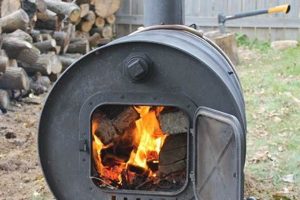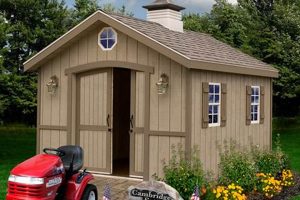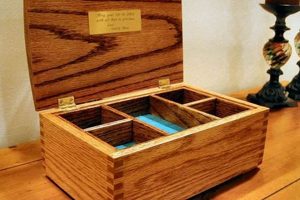A self-constructed container, typically crafted from lumber, designed for the storage of playthings. These receptacles serve to organize and consolidate a collection of children’s play items. A common example includes a rectangular structure with a hinged lid, fabricated from pine boards and secured with nails or screws.
The creation of such a storage unit offers several advantages, encompassing cost savings when compared to purchasing a pre-made equivalent. Furthermore, constructing the unit allows for customization in dimensions, materials, and aesthetic design, aligning the finished product with specific spatial requirements and personal preferences. Historically, the practice of building custom storage solutions reflects a tradition of resourcefulness and personalization in home furnishing.
The following sections will address the planning phase, material selection, construction techniques, and finishing options involved in creating a durable and aesthetically pleasing receptacle.
Construction Considerations
The subsequent guidelines address key aspects for building a reliable and functional storage receptacle for children’s playthings.
Tip 1: Material Selection: Prioritize the utilization of non-toxic wood and finishing products. Opt for lumber free from chemical treatments and ensure any paints or stains employed are certified as safe for use on children’s items. Consider the durability of the wood species, selecting hardwoods such as maple or oak for increased longevity, particularly if the receptacle will be subject to frequent or rough use.
Tip 2: Joint Construction: Employ robust joinery methods to ensure structural integrity. Dovetail joints, mortise and tenon joints, or reinforced butt joints with screws and wood glue provide greater strength than simple nail-only connections. These techniques resist the stresses of repeated opening, closing, and potential climbing by children.
Tip 3: Lid Support and Safety: Implement a lid support mechanism to prevent abrupt closure. Gas struts or piano hinges with integrated soft-close features mitigate the risk of finger pinching or accidental injury. Ensure the lid is properly aligned and moves smoothly to avoid binding or sudden drops.
Tip 4: Edge Treatment: Round or chamfer all exposed edges and corners to minimize the potential for sharp impacts. Sanding these areas smooth is essential. The application of edge banding or trim can further enhance safety and aesthetic appeal.
Tip 5: Size and Proportions: Determine appropriate dimensions based on the available space and the volume of playthings to be stored. Consider the ergonomic factors for children accessing the contents, ensuring the height is suitable for independent reach without requiring excessive stretching or climbing. A lower height can promote safer access for younger children.
Tip 6: Ventilation: Incorporate ventilation features to prevent moisture accumulation and potential mildew growth. Drilling small holes in the base or adding gaps along the sides facilitates air circulation within the enclosure.
Tip 7: Finishing and Protection: Apply a durable, non-toxic sealant or topcoat to protect the wood surface from scratches, stains, and moisture damage. Polyurethane or varnish provide a robust barrier, while maintaining the natural appearance of the wood. Multiple coats may be necessary for enhanced protection.
Adherence to these considerations will contribute to the creation of a secure and enduring storage solution, fostering both organization and child safety.
The succeeding section will explore design elements and customization options applicable to the project.
1. Wood selection
Wood selection exerts a fundamental influence on the structural integrity, longevity, and aesthetic appeal of a do-it-yourself lumber receptacle intended for plaything storage. The chosen material directly impacts the receptacle’s capacity to withstand the stresses of regular use, including weight bearing, repeated opening and closing, and potential impacts. For instance, employing softwood varieties, such as pine, provides ease of workability and affordability, but their inherent susceptibility to denting and scratching necessitates the application of robust protective finishes to ensure resilience. Conversely, hardwoods like oak or maple offer superior durability and resistance to wear, although they require more specialized tools and techniques for processing.
The selection process also extends to considerations of safety. Wood that has undergone chemical treatments for preservation purposes might release volatile organic compounds (VOCs) that could pose a health risk, particularly for young children. Therefore, opting for untreated lumber or wood sourced from sustainably managed forests is crucial. Furthermore, the presence of knots or imperfections in the wood can compromise its structural integrity and create potential splinter hazards. A practical example involves choosing clear, knot-free lumber for the lid construction to prevent weak points that could lead to breakage under stress. The color and grain pattern of the wood should also complement the intended design aesthetic of the receptacle, ensuring visual harmony within the child’s environment.
In conclusion, wood selection is not merely a matter of cost or availability, but a critical decision that directly determines the quality, safety, and suitability of the finished plaything storage unit. Overlooking these aspects can lead to premature failure, potential hazards, and a diminished overall value of the project. Careful consideration of wood species, treatment, and structural integrity is therefore essential for achieving a successful and enduring outcome.
2. Joint strength
The structural integrity of a self-constructed wooden receptacle for plaything storage is fundamentally dependent on the strength of its joints. Robust joinery ensures the receptacle’s ability to withstand the stresses of regular use, including weight bearing, repeated movement, and potential impacts. Insufficient joint strength compromises the safety and longevity of the finished product.
- Type of Joint
The selection of appropriate joint types directly affects the overall strength. Basic butt joints, secured with fasteners alone, offer minimal resistance to racking and shear forces, making them unsuitable for load-bearing components. Mortise and tenon joints, dovetail joints, or dado joints provide significantly greater surface area for adhesive bonding and mechanical interlocking, resulting in superior strength and stability. The choice of joint should align with the anticipated stress levels within the receptacle’s structure.
- Adhesive Application
The correct application of wood adhesive plays a crucial role in maximizing joint strength. Thorough surface preparation, including cleaning and sanding, ensures optimal adhesion. The adhesive must be applied evenly and in sufficient quantity to create a strong bond between the mating surfaces. Clamping the joint during the curing process is essential for maintaining proper alignment and maximizing the adhesive’s bonding strength. Using appropriate wood glue such as Polyurethane and PVA adhesive for end grain wood will provide adequate joint strength.
- Fastener Reinforcement
While strong joinery techniques are paramount, the strategic use of fasteners can further enhance joint strength. Screws, in particular, offer greater holding power than nails and provide increased resistance to pulling forces. Pre-drilling pilot holes prevents wood splitting and ensures proper fastener engagement. The type and size of fastener should be appropriate for the wood species and the joint configuration. The use of pocket hole joinery can be used if you lack the tools to produce traditional joint.
- Long-Term Durability
The impact of environmental factors on joint strength is a significant consideration. Fluctuations in humidity and temperature can cause wood to expand and contract, potentially weakening adhesive bonds and compromising structural integrity. Selecting appropriate wood species and applying protective finishes can mitigate these effects. Regular inspection and maintenance are necessary to identify and address any signs of joint weakening or failure over time.
The integration of these facets of joint strength directly determines the functionality and safety of a self-made storage unit. Employing robust joint construction techniques, combined with appropriate adhesive application, fastener reinforcement, and consideration of environmental factors, ensures a durable and reliable solution for organizing playthings. Failure to address these aspects can lead to premature failure of the receptacle, posing potential hazards and diminishing its overall utility.
3. Lid safety
The integration of lid safety mechanisms is paramount in the construction of a do-it-yourself wooden receptacle for playthings. An improperly designed or executed lid poses a significant risk of injury, particularly to young children. The potential for a heavy lid to slam shut, trapping fingers or causing head trauma, necessitates the inclusion of features designed to mitigate these hazards. The absence of such safeguards directly contravenes the intended purpose of the receptacle, which is to provide a safe and organized storage solution.
Effective lid safety features include soft-close hinges, which prevent the lid from slamming shut by employing a dampening mechanism to control the rate of closure. Gas struts offer an alternative, providing support to keep the lid open at various angles and preventing sudden drops. A practical example involves a receptacle constructed with a heavy oak lid lacking any form of support. Without a safety mechanism, the lid could easily fall unexpectedly, resulting in injury. Conversely, the incorporation of soft-close hinges ensures a controlled and gentle closing action, significantly reducing the risk of harm. Lid support must also be adequate, to ensure long-term support. Poorly installed hinges can fail, causing the lid to become a hazard.
The commitment to lid safety extends beyond the selection of appropriate hardware. Careful attention to lid weight, hinge placement, and overall structural integrity is essential. The design should prioritize ease of use for children while simultaneously minimizing the potential for accidental injury. The failure to address lid safety represents a critical oversight in the design and construction process, undermining the intended benefits of the storage unit and posing a tangible threat to child safety. Thorough planning, selection of appropriate components, and meticulous execution are crucial for ensuring a safe and functional finished product.
4. Size appropriate
The dimensional characteristics of a self-constructed wooden receptacle for storing playthings are directly correlated with its functionality and safety. A “size appropriate” receptacle considers the age and physical capabilities of the intended user, the volume of items to be stored, and the available space within the designated environment. An undersized receptacle may prove inadequate for containing the intended contents, leading to spillage and disorganization. Conversely, an oversized receptacle may present challenges for access, particularly for young children, and could occupy an excessive amount of space. The relationship between size and utility is therefore critical to the successful implementation of such a storage solution.
A real-world example of the importance of “size appropriate” lies in the construction of a storage receptacle for a toddler’s playroom. A receptacle that is too tall may require the child to reach excessively or climb, increasing the risk of falls. A receptacle that is excessively deep may make it difficult for the child to locate and retrieve items from the bottom. Conversely, a receptacle designed with a low profile and shallow depth allows the child to easily access and manage their belongings, fostering independence and promoting organizational skills. The dimensions must also conform with other objects in the environment. A very big toy box may hinder the movement of other objects.
In summary, the concept of “size appropriate” is not merely an aesthetic consideration but a fundamental design principle that directly impacts the functionality, safety, and utility of a self-made lumber-based storage container for playthings. Accurate assessment of user needs, storage requirements, and spatial constraints is essential for achieving a balanced and effective solution. Overlooking this aspect can lead to a receptacle that is either impractical or potentially hazardous, negating the intended benefits of the project.
5. Finish toxicity
The selection of finishing materials for a self-constructed wooden receptacle intended for plaything storage demands careful consideration of potential toxicity. Finishes applied to such items may come into direct contact with children, necessitating the use of products that are demonstrably safe and free from harmful substances. The term “finish toxicity” encompasses the potential for these materials to release volatile organic compounds (VOCs) or contain heavy metals, posing risks to respiratory health and overall well-being.
- VOC Emission Levels
Many conventional paints, stains, and sealants contain VOCs, which evaporate into the air and can cause respiratory irritation, headaches, and other adverse health effects. The selection of low-VOC or zero-VOC finishes is crucial in minimizing exposure, particularly in enclosed environments such as children’s playrooms. For example, water-based acrylic paints and certain natural oil finishes offer viable alternatives with significantly reduced VOC emissions. Prioritizing products with third-party certifications, such as GREENGUARD, ensures adherence to stringent emission standards.
- Heavy Metal Content
Historically, some paints and finishes contained heavy metals like lead, which is known to be highly toxic, especially to children. While lead-based paints are now largely prohibited, it remains essential to verify that any finishing products used are explicitly lead-free and do not contain other harmful heavy metals such as cadmium or mercury. Opting for reputable brands with transparent ingredient disclosure reduces the risk of inadvertent exposure. Checking the safety data sheet (SDS) will provide crucial details for your needs.
- Allergenic Potential
Certain individuals may exhibit allergic reactions to specific chemicals or substances present in finishing materials. Common allergens include formaldehyde, isothiazolinones, and certain dyes. Selecting hypoallergenic finishes and conducting thorough research on potential allergens is advisable, particularly for children with known sensitivities. Natural oil finishes, while generally low in VOCs, may contain nut oils, posing a risk to children with nut allergies. Always ensure the list of ingredients.
- Durability and Degradation
The long-term durability and potential degradation of finishing materials must also be considered. Finishes that break down easily or release particles over time can increase the risk of exposure to harmful substances. Selecting durable, non-brittle finishes that are resistant to chipping and peeling minimizes the potential for ingestion or inhalation of hazardous materials. Regularly inspecting the finish for signs of wear and tear and promptly addressing any damage further reduces the risk of exposure.
In conclusion, a comprehensive understanding of “finish toxicity” is indispensable when constructing a do-it-yourself wooden receptacle for playthings. Selecting low-VOC, lead-free, hypoallergenic, and durable finishing materials is paramount for ensuring the safety and well-being of children. The use of certified products, thorough research, and diligent maintenance are essential for minimizing the potential for exposure to harmful substances and maximizing the longevity of the finished product.
6. Base ventilation
The inclusion of base ventilation in a do-it-yourself wooden receptacle for plaything storage represents a critical design consideration that directly impacts the long-term preservation of both the receptacle itself and the stored items. This feature mitigates the accumulation of moisture and associated issues, fostering a healthier and more durable storage environment.
- Moisture Control
Ventilation facilitates the circulation of air within the receptacle, preventing the buildup of humidity that can promote mold and mildew growth. An enclosed, unventilated space creates an ideal environment for moisture to condense, particularly in climates with high humidity levels. The presence of ventilation allows for the dissipation of this moisture, thereby inhibiting the proliferation of harmful microorganisms and reducing the risk of damage to wooden components.
- Odor Reduction
The accumulation of moisture can also lead to the development of unpleasant odors within the storage receptacle. Playthings, particularly those made of fabric or absorbent materials, may harbor residual moisture or attract spills, contributing to the formation of musty or stale odors. Adequate ventilation allows for the dissipation of these odors, maintaining a fresher and more hygienic storage environment. This is particularly beneficial for items that are infrequently used or stored for extended periods.
- Material Preservation
Consistent exposure to high humidity levels can cause wooden components to warp, swell, or rot, compromising the structural integrity of the storage receptacle. Ventilation helps to maintain a more stable moisture content within the wood, reducing the likelihood of these detrimental effects. This is especially important for receptacles constructed from softwood varieties, which are inherently more susceptible to moisture damage. Furthermore, proper ventilation protects stored playthings from moisture-related deterioration, preserving their condition and extending their lifespan.
- Construction Methods
The implementation of base ventilation can be achieved through several construction methods. The inclusion of evenly spaced ventilation holes along the base of the receptacle provides a simple and effective means of promoting airflow. Alternatively, the construction of a slightly elevated base, supported by feet or runners, creates a gap between the receptacle and the floor, allowing for air circulation from below. The size and placement of ventilation features should be carefully considered to ensure adequate airflow without compromising the structural stability of the receptacle. Inadequate space can inhibit airflow.
The incorporation of base ventilation within a DIY wooden toy box is integral to maintaining a safe, hygienic, and durable storage solution. By mitigating moisture accumulation, reducing odors, and preserving materials, this seemingly minor design element contributes significantly to the long-term functionality and value of the project.
7. Edge smoothness
The concept of edge smoothness holds paramount significance in the construction of a do-it-yourself wooden receptacle designed for plaything storage. This attribute transcends mere aesthetic appeal, directly influencing the safety, usability, and overall quality of the finished product. A lack of edge smoothness can present hazards, particularly for young children, while a well-executed smoothing process enhances both the tactile experience and the long-term durability of the receptacle.
- Injury Prevention
Sharp or splintered edges on a wooden receptacle pose a direct risk of cuts, abrasions, and splinters, particularly during frequent use by children. Ensuring edge smoothness through sanding, routing, or the application of edge banding minimizes these potential injuries. A receptacle constructed with unfinished, rough-cut lumber presents a clear and present danger, while one meticulously smoothed and rounded reduces the likelihood of harm. For example, a toy box left with sharp edges will expose children to cut injury.
- Enhanced Tactile Experience
Smooth edges contribute to a more pleasant tactile experience. A receptacle with well-sanded and finished edges feels more comfortable to handle, encouraging regular use and minimizing tactile discomfort. The tactile quality is particularly important for items intended for use by children, as their sensitivity to textures and surfaces is often heightened. A simple test can confirm that smooth edges would be safer.
- Improved Finish Adhesion
Smooth edges provide a more receptive surface for the application of paints, stains, and sealants. Rough or splintered edges can impede the adhesion of these finishes, resulting in uneven coverage and a diminished aesthetic appearance. Proper edge preparation ensures that the finish adheres uniformly, enhancing its protective qualities and prolonging the life of the finished product. A sanded edge provides a better surface for paint.
- Prevention of Splintering
Over time, unfinished or inadequately smoothed edges are prone to splintering, creating a source of potential injury and detracting from the overall appearance of the receptacle. Proper edge smoothing helps to seal the wood fibers, preventing them from separating and forming splinters. This is particularly important for receptacles constructed from softwood varieties, which are more susceptible to splintering than hardwoods. Sanding the surface would prevent further splinters.
In conclusion, the pursuit of edge smoothness in a DIY wooden toy box is not merely a cosmetic concern but a fundamental aspect of ensuring safety, enhancing usability, and promoting long-term durability. Neglecting this element compromises the value and functionality of the receptacle, while prioritizing edge smoothing contributes significantly to a well-crafted and child-friendly storage solution.
Frequently Asked Questions
The following addresses common inquiries regarding the construction and utilization of self-made lumber receptacles intended for the storage of playthings. These questions aim to provide clarity on essential aspects of design, construction, and safety.
Question 1: What wood species are most suitable for constructing a durable storage receptacle?
Hardwoods such as oak and maple offer superior durability and resistance to wear, making them ideal choices for high-use environments. Softwoods like pine are more affordable and easier to work with, but require robust protective finishes to mitigate denting and scratching.
Question 2: What safety precautions should be observed when selecting finishing materials?
Prioritize the use of low-VOC or zero-VOC paints, stains, and sealants to minimize exposure to harmful chemicals. Ensure that all finishing materials are explicitly lead-free and non-toxic, particularly for items intended for use by children. Third-party certifications, such as GREENGUARD, can provide added assurance of product safety.
Question 3: How can the risk of lid-related injuries be mitigated?
Incorporate soft-close hinges or gas struts to prevent the lid from slamming shut unexpectedly. These mechanisms provide a controlled and gentle closing action, reducing the risk of finger pinching or head trauma. Ensure that the lid is properly aligned and moves smoothly to avoid binding or sudden drops.
Question 4: What is the recommended approach for ensuring adequate ventilation within the receptacle?
Drill evenly spaced ventilation holes along the base of the receptacle to promote airflow. Alternatively, construct a slightly elevated base, supported by feet or runners, to create a gap between the receptacle and the floor. These features help to prevent moisture accumulation and associated issues, such as mold and mildew growth.
Question 5: How can the structural integrity of the receptacle’s joints be maximized?
Employ robust joinery techniques, such as mortise and tenon joints, dovetail joints, or dado joints, to provide superior strength and stability. Reinforce joints with screws and wood glue, ensuring proper surface preparation and clamping during the curing process. Select appropriate wood species and apply protective finishes to mitigate the impact of environmental factors on joint strength.
Question 6: Why is edge smoothness considered a critical design element?
Smooth edges prevent cuts, abrasions, and splinters, particularly during frequent use by children. Edge smoothing enhances the tactile experience, improves finish adhesion, and prevents splintering over time. This process ensures that the receptacle is both safe and aesthetically pleasing.
These FAQs highlight core areas of attention for the production of the lumber receptacle, ensuring safety and quality.
The subsequent segment focuses on design customization and aesthetic considerations applicable to the creation of a custom plaything storage solution.
Conclusion
The preceding discussion has elucidated the multifaceted considerations inherent in the creation of a self-constructed lumber receptacle for plaything storage, often referred to as a “diy wooden toy box.” Emphasis has been placed on material selection, joint strength, lid safety mechanisms, dimensional appropriateness, finish toxicity mitigation, base ventilation strategies, and the attainment of edge smoothness. Each of these elements contributes directly to the functionality, safety, and longevity of the finished product.
The information presented should serve as a foundation for informed decision-making in the pursuit of such projects. Diligent application of these principles will result in a storage solution that not only effectively organizes playthings but also prioritizes the well-being of its users. The construction of a durable and safe storage unit demands a commitment to quality and attention to detail throughout the entire process.







